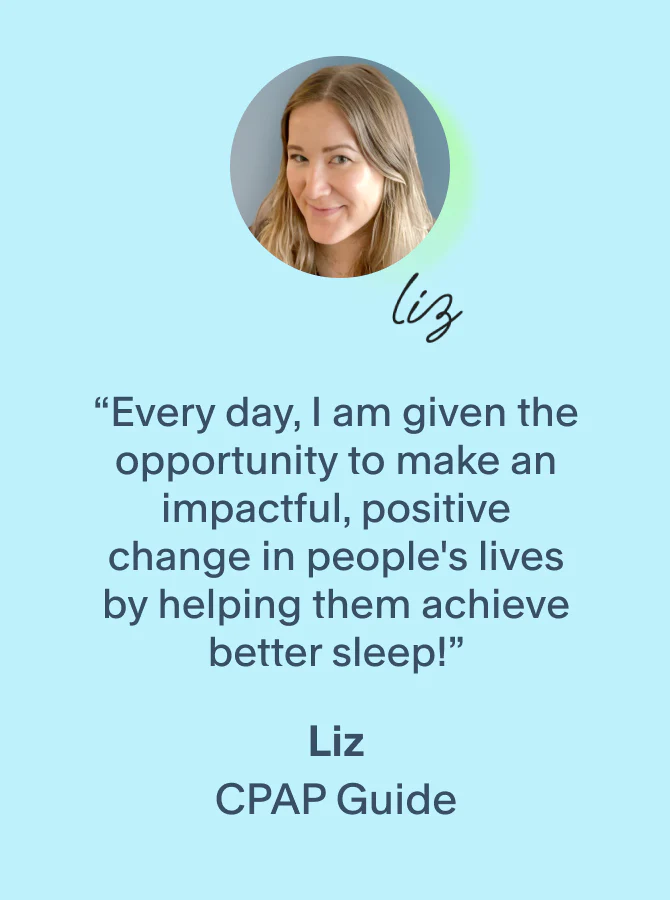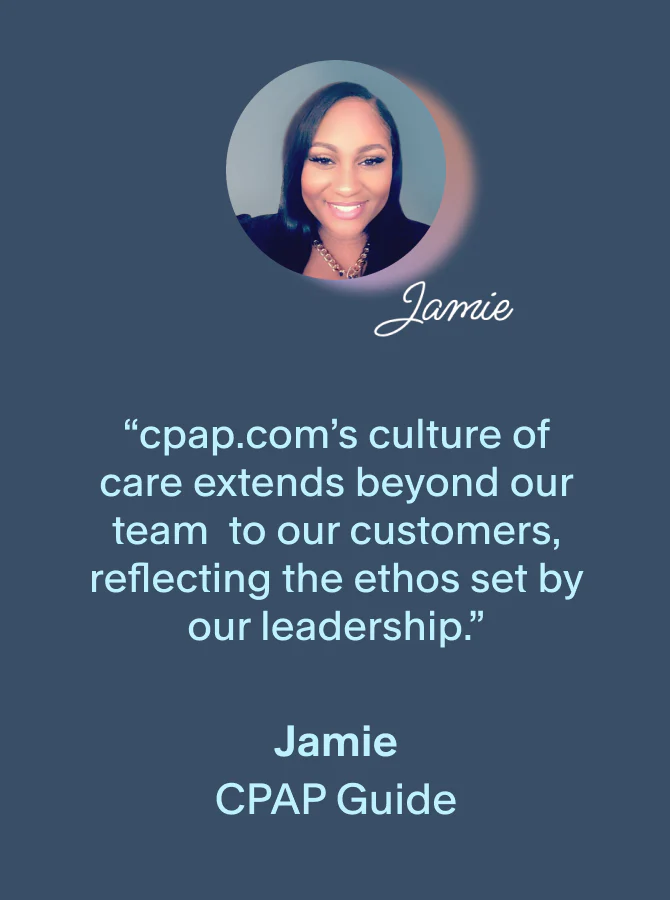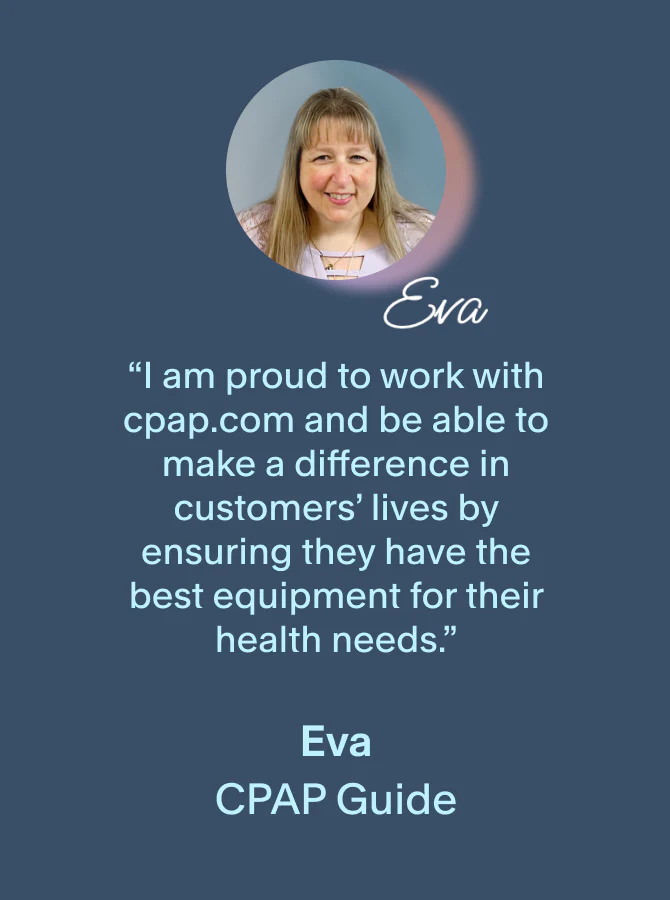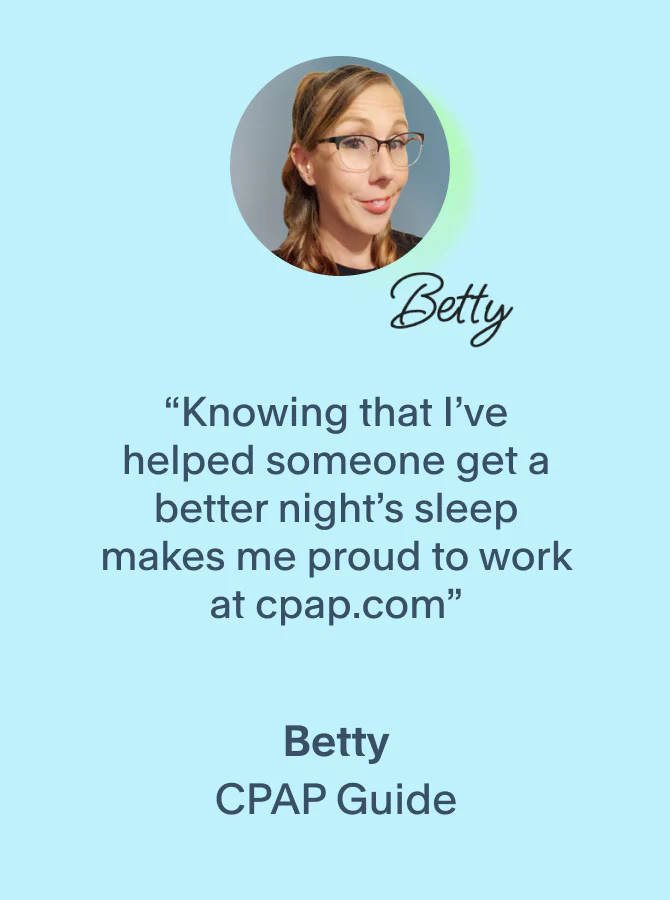CPAP therapy is the gold standard for treating sleep apnea, but it's not right for everyone. Many people struggle with bulky equipment, discomfort, or simply staying compliant with CPAP therapy. That’s where EPAP (Expiratory Positive Airway Pressure) comes in.
In this guide, we’ll explain what EPAP is, how it works to treat obstructive sleep apnea, and how it compares to a CPAP machine in terms of comfort, effectiveness, cost, and convenience.
Whether you're seeking an alternative to traditional therapy or exploring options for mild sleep apnea, understanding the difference between EPAP versus CPAP can help you make the right decision for your sleep health.
Table of contents
At a Glance: Comparing EPAP to CPAP therapy
EPAP is a simple, machine-free alternative to CPAP therapy that uses your own breath to create airway pressure, making it a good solution for people who find CPAP machines to be bulky or uncomfortable.
EPAP is great for nose breathers with mild to moderate sleep apnea, but they are not suitable for severe OSA or mouth breathing.
These devices are travel-friendly, compact, quiet, and don’t require electricity, tubing, or a humidifier.
Fewer side effects, plus easier cleaning and maintenance, with no filters or water chambers to maintain—just rinse the nasal inserts.
Talk to your doctor to see if EPAP is right for you, especially if you’ve struggled with CPAP or have mild OSA.
Can EPAP be used as a CPAP alternative to treat sleep apnea?
EPAP therapy works well as an alternative to CPAP when it is used to treat simple cases of mild or moderate obstructive sleep apnea.
EPAP devices can only be used while nose breathing, and they are not suggested for people with complex medical conditions.
Ideally, EPAP may be suggested as a first-line treatment for some people with an AHI score below 15, though it may also be prescribed for moderate OSA (AHI of 15-30).
Science Says
A 2011 study showed that EPAP therapy significantly improved signs and symptoms in people with mild to moderate cases, resulting in:
- Lower AHI scores
- Reduced daytime sleepiness
- Better therapy compliance
What is EPAP therapy?
Expiratory Positive Airway Pressure (EPAP) is a treatment method for snoring and Obstructive Sleep Apnea. It involves trapping some of the air exhaled by your lungs to create a pocket of pressurized air that keeps your airway open between each breath.
EPAP devices are often described as an alternative to CPAP therapy because they both use air pressure to prevent airway blockages caused by the tongue, soft palate, tonsils, and other surrounding soft tissues.
The EPAP process tends to produce lower amounts of air pressure compared to the maximum capabilities of a CPAP machine, which is why it is usually only prescribed in cases of snoring or mild to moderate OSA.
How does EPAP work?
An EPAP device prevents airway obstructions. It works by partially blocking the release of air when you exhale. When that air is held back it becomes pressurized and acts as a brace for the soft structures in your nasal cavity, mouth, throat, and airway, making it easier to breathe.
EPAP prevents the release of air during exhalation
When using an EPAP device, you are able to inhale normally. However, when you exhale, part of the air that flows out of your body is held back, which increases the air pressure in your upper airways, also known as expiratory positive airway pressure. This process is made possible by a small, one-way valve that allows air to flow in while preventing it from flowing out.
Exhalation vents prevent EPAP discomfort
EPAP devices also feature tiny vents that release small amounts of excess air when needed. This design prevents the air pressure build-up from becoming too high. It also reduces Positive Airway Pressure discomfort and makes it much easier to maintain a steady breathing pattern.
EPAP works best with nasal breathing
Expiratory pressure can be created while breathing through your mouth. However, virtually all currently available EPAP devices are designed for nasal breathing. This is because nasal expiratory positive airway pressure is easier to create and is believed to be more effective.
Products that utilize this specific method of PAP therapy are called Nasal EPAP devices. These tend to look and feel similar to a CPAP nasal pillow mask and usually feature nasal pillows or prongs that insert directly into the nostrils.
Who can use EPAP therapy?
If you are considering trying EPAP therapy, it’s important to keep in mind that it is not suitable for everyone. Before making any decisions, you need to discuss your health history and treatment requirements with your doctor. Most healthcare providers will require you to meet the following criteria to be considered eligible for an EPAP device.
There are also instances where an EPAP device may be combined with other forms of sleep apnea treatment, such as Positional Therapy or Oral Appliance Therapy.
Have a diagnosis of mild or moderate OSA
Have an AHI score of no more than 30 without sleep apnea treatment
Do not require high-pressure PAP therapy
Be a nose breather
Keep your mouth closed while you sleep
How does EPAP compare to CPAP?
EPAP and CPAP both fall under the category of Non-Invasive Positive Airway Pressure therapy, which uses positive pressure air to keep the airway open during sleep.
EPAP therapy works very differently from CPAP therapy
The biggest difference between CPAP versus EPAP is how each device creates and delivers this pressurized air, CPAP machines create PAP air, while EPAP devices use the air coming from your own lungs.
CPAP machines keep the airway open by producing pressurized air and then delivering it to your airway through a tube. The flow of pressurized air is constant during all stages of breathing, whether you are inhaling or exhaling.
EPAP devices temporarily trap the air you exhale, creating a pocket of pressurized air that holds the airway open while you breathe in, allowing fresh air to enter your lungs.
CPAP can be used by more people to treat their sleep apnea
CPAP machines have been proven to effectively treat all different types and severities of sleep apnea and can be used by people who breathe through their mouths. But despite their successful history, CPAP can have a lot of drawbacks.
EPAP can effectively treat sleep apnea in the right conditions, but it doesn’t work for everyone. Typically, these devices are used to treat snoring and mild sleep apnea. They may also be used by people with moderate sleep apnea who have failed CPAP compliance.
EPAP devices are easier to use compared to CPAP machines
Your doctor is more likely to suggest trying EPAP if you have struggled with CPAP therapy in the past because EPAP devices are generally a lot easier to use and are more comfortable.
EPAPs are very minimalistic compared to CPAP therapy, which requires bulky machines and hoses.
Unlike CPAP, EPAP devices don't even require a power source because they use valves to create air pressure rather than a machine, making them a popular solution for travelers with sleep apnea.
Choosing the correct nasal pillow size can take some trial and error, but once you have that figured out, simply insert it into your nostrils, and it’s ready to work!
EPAP therapy versus CPAP therapy
| EPAP Therapy | CPAP Therapy | |
|---|---|---|
| Uses exhaled air to create pressurized air inside nasal pillows | How It Works | Machine pressurizes air then delivers constant airflow through tubing |
| Snoring, mild-moderate OSA | Treated Conditions | All types of sleep apnea |
| Yes | Prescription Required | Yes |
| None | Power Source | Electricity or battery |
| Lightweight & compact | Size | Bulky, may cause claustrophobia |
| Small nasal pillows with slim head strap | Equipment | Machine, tubing, mask, humidifier |
| Wipe nasal pillows daily, wash nasal pillows & head strap weekly | Cleaning | Wipe mask cushion and hang tubing to dry daily, wash mask cushion, head strap, water chamber, and tubing weekly |
| ~$150-$350 | Initial Cost | $900-$1400 |
| ~$300+ per year | Annual Cost | ~$750+ per year |
| Sometimes covered | Insurance | Almost always covered |
| More travel-friendly | Travel | Less travel-friendly |
| Nose irritation | Side Effects | Irritation, red marks, swallowing air |
| Higher | Compliance | Lower |
Is EPAP therapy right for you?
EPAP therapy may be a good option if you need…
Fewer side effects: EPAP has more minimal and gentler than traditional CPAP.
No power source: Great for power outages, camping, or off-grid travel.
More comfort: No pressurized airflow or bulky headgear to adjust to.
Less equipment: Skip the mask, hose, and machine—EPAP keeps it simple.
Travel-friendly therapy: Small, quiet, and easy to pack.
Lower upfront cost: EPAP options are often more affordable than CPAP setups.
Simpler cleaning: Just clean your EPAP device—no tanks, hoses, or filters.
Better long-term use: Many find EPAP easier to stick with than CPAP.
CPAP therapy will be a better solution if you need…
Higher pressure support: EPAP can’t deliver the pressure levels some people need.
Treatment for severe sleep apnea: EPAP isn’t recommended for severe cases.
Help with central sleep apnea: EPAP only treats obstructive sleep apnea.
A solution for mouth breathing: EPAP doesn’t work well if you breathe through your mouth.
Therapy flexibility when sick: CPAP lets you switch to a full face mask if your nose is congested.
Access to expert support: CPAP has a larger network of guides, providers, and communities.
Better insurance coverage: CPAP is more widely accepted and covered by insurance.
What is the best EPAP device?
The FDA has approved multiple EPAP devices that treat snoring and OSA, most of which are available with a prescription and range from $100 to $300 per year.
One popular option is the Bongo RX, which is primarily used as an alternative to CPAP when treating mild OSA and occasionally snoring.
When choosing an EPAP device, keep in mind that studies suggest that the ULTepap creates higher EPAP pressures, making it a more suitable option if you have moderate sleep apnea.
On the other hand, if you’re looking for an easy way to treat snoring without a prescription, you may want to check out the Optipillow.
Frequently asked questions
What are the best alternatives to CPAP therapy?
Other alternatives to CPAP therapy include lifestyle changes, Positional Therapy, Oral Appliance Therapy, sleep apnea exercises, and surgery.
Does EPAP work for mouthbreathers?
All of the EPAP devices that are on the market today utilize nasal EPAP, meaning they are intended for nose breathers only. If you have a deviated septum, chronic congestion, or some other issue that prevents you from being able to breathe through your nose, you should not use a nasal EPAP.
What is the difference between EPAP and IPAP?
EPAP refers to the amount of air pressure applied to the airway during exhalation, while IPAP refers to the air pressure sent to the airway during inhalation.
Does EPAP require a prescription?
The majority of effective EPAP devices are only available with a prescription. If you are looking for an EPAP device that manages mild to moderate Obstructive Sleep Apnea, you will need a prescription. Devices that solely address snoring are usually available without a prescription.
Final thoughts
CPAP therapy has long been considered the primary treatment for sleep apnea. However, it has its downsides, and many sleep apnea experts believe EPAP therapy is a promising alternative to CPAP under the right conditions.
Still, it’s important to remember that treating sleep apnea with EPAP alone is only an option for a very select group of people. When comparing CPAP versus EPAP, EPAP may be more comfortable and easier to use, but CPAP does a better job of treating severe sleep apnea and Central Sleep Apnea.
You should always speak with your doctor before changing your sleep apnea treatment plan. So, if you have mild or moderate Obstructive Sleep Apnea and want to know more about switching from CPAP therapy, talk to your doctor about trying EPAP!
Need help? Contact us!
- Call: 1-800-356-5221
- Email: support@cpap.com
- Chat: Connectwith a CPAP Guide through our website or app










